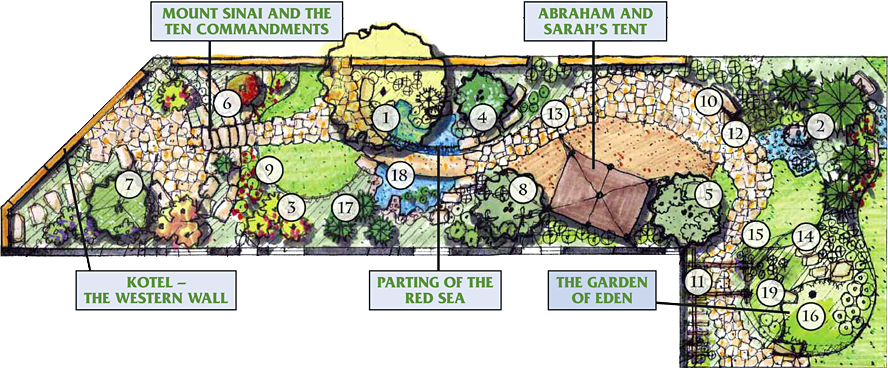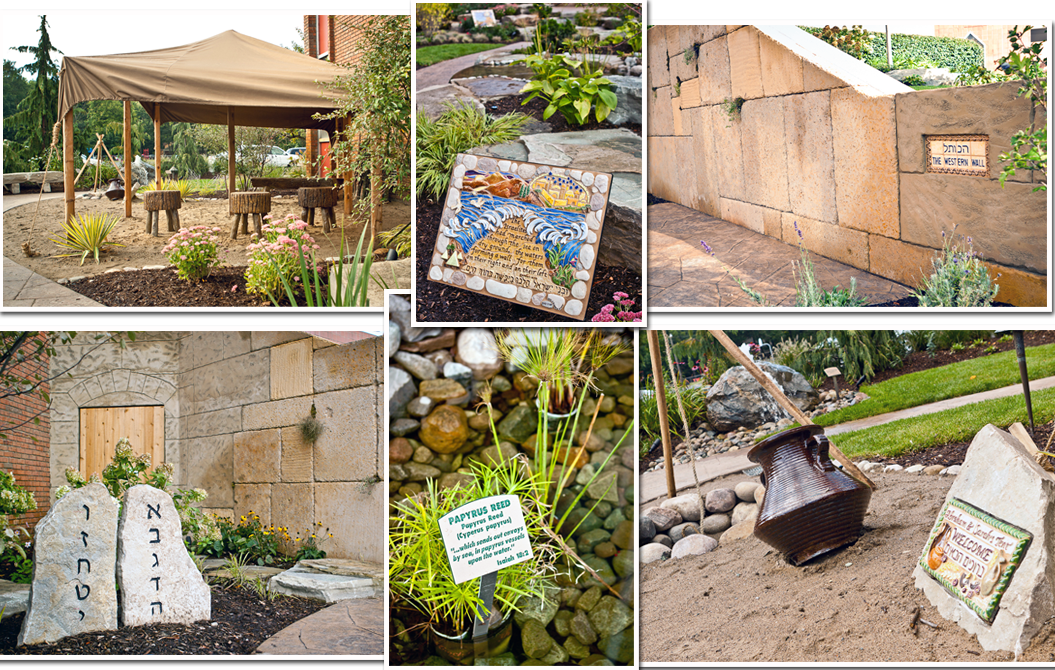

Identifying Biblical plants is not a simple task. Although the Israelites were seemingly very familiar with plants they used for medicine, food, construction, anointing, and feeding livestock, they were clearly not botanists. Plant attribution and connection to the Bible are based on a number of sources but please note that much uncertainty remains and we will never conclusively know the origins, relevance and meaning of some of them.

1. Sweet Gum – צרי “...camels bearing gum, balm and ladanum…” Genesis 37:25. This member of the pea family, the Sweet Gum Tree gets its name for the substance that can be collected from cutting off the stems. The gum was among the local products that appeared along the trade route in the Fertile Crescent. The gum was one of the items that the Ishmaelites carried in their caravans. Another famous passenger in the caravan was Joseph, whose brothers sold him to the Ishmaelites in exchange for 20 shekels.
2. Cedar Tree – ארז “ The righteous bloom like a date-palm; they thrive like a cedar in Lebanon.” Psalms 92:13. The Cedars of Lebanon are referenced many times in the Bible. King Solomon bought cedar trees from the King of Tyre (coast of Lebanon), to use to construct his temple and to also make furniture and ships. The cedar grows slowly but reaches heights of up to 120 feet. This tree is acclaimed for its strength and beauty so that the psalmist uses the cedar as the metaphor for righteous people.
3. Rose of Sharon – חבצלת השרון “ I am a Rose of Sharon, a lily of the valleys.” Song of Songs 2:1. This plant is mentioned in the Biblical book “Song of Songs”, which recounts a love story between man and woman. The speaker calls himself a “Rose of Sharon” and his beloved “a lily among thorns”. The famous medieval commentator, Rashi, considers this story a metaphor of the love between God and the Jewish people. Although the name of the plant is well known, its precise identity is uncertain and it is not really a rose.
4. Apple Tree – תפוח “Sustain me with raisin cakes, refresh me with apples, for I am faint with love.” Song of Songs 2:5. A common misconception is that the apple was the fruit Adam and Eve consumed from the Tree of Knowledge in the Garden of Eden. In fact, apple is not even mentioned in the first book of the Bible. Although not known with certainty, many scholars believe the Tree of Knowledge may have actually been a fig or apricot tree. Apple trees require adequate water and moderate temperatures, which suggests that the apple tree was not indigenous to the Land of Israel but was cultivated only in specific fertile regions in the north of the country.
5. Olive Tree – זית “The dove came back to him toward evening; and there in its bill was a plucked-off olive leaf.” Genesis 8:11. The olive tree was an essential crop during biblical times as its oil was used to create food, lamp fuel, soap, and ointments for the average Israelite. It was also used for ritual purposes like the anointments of priests and kings. The olive tree is mentioned about 25 times and the oil of the olive is mentioned about 160 times in the Bible. It was a leaf from an olive tree that the dove retrieved for Noah following the flood. The olive tree is famous for both its beauty and its longevity, as its lifespan may exceed 1000 years. The olive tree was unquestionably one of the most valuable trees to the ancient Hebrew people.
6. Burning Bush – סנה בוער באש “He gazed, and there was a bush all aflame, yet the bush was not consumed.” Exodus 3:2. When tending his father-in-law’s flock, Moses noticed the peculiar site of a bush burning with fire that was not being consumed. The Torah does not identify the type of bush, yet the Talmud teaches that the bush was full of thorns. A story is told in a Jewish Commentary (the Midrash) that a person once asked Rabbi Joshua ben Korha why God appeared to Moses in such a low type of bush. The rabbi responded, “there is no place where the Divine Presence is not to be found, even in a lowly bush.” (Exodus Rabbah 2:9)
7. Almond Tree – שקד “…for the almond tree may blossom…” Ecclesiastes 12:5. A member of the peach family, the almond tree is a symbol for efficiency, as the almond tree is the first to blossom after the winter and highlights the awakening of spring. Jacob sent almonds with his sons when they went down to Egypt to seek food during the time of famine. The almond also represents Divine Favor, as Aaron’s staff blossomed with almonds following a rebellion in the desert. Almonds are mentioned six times in the Bible.
8. Willow – ערבה “…and willows of the brook, and you shall rejoice before the Lord…” Leviticus 23:40. Willow, myrtle, date palm, and a citron fruit are the four species that we shake on Sukkot. Another name for Sukkot is Hag Ha’asif, or the Gathering Holiday, when our ancestors would rest following the collection of the crops that grew throughout the year. Willow trees are common near the Jordan River as they require large quantities of water. The wood of a willow is soft and not very durable. The narrow stems were used to make bowls, baskets and utensils. Some speculate they may have also been used by Delilah to bind Samson.
9. Rose – חבצלת “The arid desert shall be glad, the wilderness shall rejoice and shall blossom like a rose.” Isaiah 35:1. Next to the lily, the rose is the most famous flower of the Bible. Roses were well known in Europe at the time of Biblical translations so many scholars believe that the common translation of the תלצבח , to rose is more likely than not, a mistranslation of the flower תלצבח . Probably no other plant in the Bible has been so misrepresented in translation. Roses are, however, native to Israel, in their white or light pink coloring. Roses are in the genus Rosa and have been cultivated since ancient times.
10. Reed Grass – אחו “...when out of the Nile there came up seven cows, handsome and sturdy, and they grazed in the reed grass.” Genesis 41:2. The reed has canes that resemble bamboo, and while they are not particularly strong, can grow up to 12 feet high. Reeds are waterside plants and can be found both in Egypt and in Israel. Miriam placed her baby brother Moses in a basket among the reeds where he eventually floated to Pharaoh’s daughter, who took him into the palace.
11. Grapes – גפן “…a land of wheat and barley, of vines, figs, and pomegranates, a land of olive trees and honey...” Deuteronomy 8:8. The psalmist teaches that wine “gladdens the heart”, and wine from the grape vine certainly plays an important role in the Bible and in Jewish ritual life today. Upon seeing the destruction resulting from the flood, Noah is the first man in the Bible to become drunk. Yet wine is also associated with good fortune. When Joseph was imprisoned in Egypt, he correctly interpreted the dreams of Pharaoh’s servants. Pharaoh’s Wine Minister, commonly referred to as the butler, saved Joseph from jail. The Torah counts grapes among the seven species of the Land of Israel. Grapes are the fruit of the vine, and nearly every Jewish ritual includes sanctifying the time over wine.
12. Onion – בצל “…the melons ,the leeks, the onions, and the garlic.” Numbers 11:5. In the second year of their wandering in the desert, the Children of Israel complain about almost everything! In their yearning for the “good old days”, they gripe that when they were in Egypt, they didn’t have to consume the manna, but rather were provided with melons, leeks, onions, and garlic in Egypt. This complaint in Numbers 11 is the only reference to onion in the Bible.
13. Thistle – דרדר “Thorns and thistles shall it sprout for you. But your food shall be the grasses of the field.” Genesis 3:18. Thistles are nonwoody plants that are outfitted with prickles, one of three different kinds of plant armor recognized by botanists. Genesis recounts that the thistle was introduced as a punishment to Adam for eating from the fruit of the Tree of Knowledge of Good and Evil. There are over 100 different types of thistle growing abundantly in Israel today and they are very conspicuous along roads and in fields. Anyone who hikes in Israel comes away with a few scratches and quickly “gets the point”!
14. Lily – שושן “I am my beloved’s and my beloved is mine; He browses among the lilies.” Song of Songs 6:3. Many scholars think that the term lily may be a generic term that the Bible uses for all flowers. Multiple species of lilies have been growing in Israel since Biblical times. The lily appears in several locations in the Bible, particularly in Song of Songs, a poetic book utilizing nature as metaphors for the love between man and woman. King Solomon, to whom Song of Songs is attributed, also planted lilies in his garden. They are also believed to have been used as ornaments for the Temple.
15. Garlic – שום “…the melons, the leeks, the onions, and the garlic” Numbers 11:5. Although garlic was used regularly in the biblical period, it appears only once in the Bible, next to the singular reference of the onion. Both garlic and onion were considered lavish foods in the biblical period. Garlic and onion resemble each other but only garlic has multiple bulbs. Garlic was used by the ancient Israelites to treat melancholy and hypochondria and in modern times, is reported to be useful in lowering the incidence of cancer.
16. Lily of the Valley – שושנה “I am a Rose of Sharon, a lily of the valleys.” Song of Songs 2:1. Many legends have developed about this flower. One story teaches that upon banishment from the Garden of Eden, Eve’s tears produced the plant of the Lily of the Valley. The lily of the valley appears often in the love poetry of Song of Songs.
17. Cypress – ברות “Cedars are the beams of our house, cypresses the rafters.” Song of Songs 1:17. The cypress is mentioned several times in the Bible. It is a conifer, a cone-bearing tree with strong durable wood and scalelike small leaves, which are different than pine and cedar leaves. Cypress wood was highly valued by the ancients. Some scholars believe that this is the “gopher wood” that Noah used to construct his ark.
18. Papyrus Reeds – גומא “…which sends out envoys by sea, in papyrus vessels upon the water.” Isaiah 18:2. Papyrus is usually associated with Egypt, as it grew along the banks of the Nile River. It is often referred to in the Bible as bulrushes or reeds. Papyrus was not only used for paper but also for constructing shoes, huts, ropes, and mats. Its dried root could also be used for fuel. Papyrus appears in the Bible associated with boats and water. Moses’ basket was constructed out of papyrus.
19. Lily – שושנה “like a lily among thorns, so is my darling among the maidens” Song of Songs 2:2. The prophet Hoshea speaks of the love between God and the People of Israel in metaphor: “I will be like the dew to Israel; he shall blossom like the lily”. Lilies grow to about 3 feet tall, and then buds develop from the stem with flowers opening in succession during the summer.